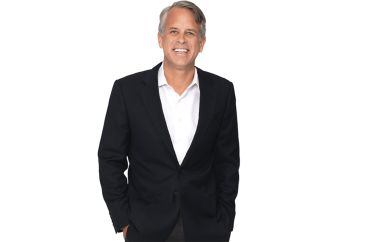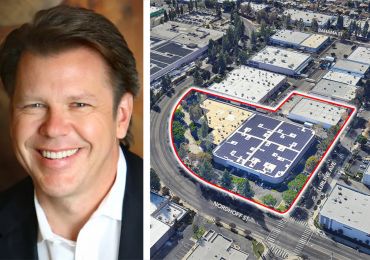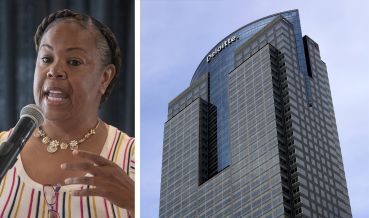Hollywood’s New Script: Miami Neighbor Sees Major Development
By Mike Seemuth January 20, 2022 10:46 am
reprints
Hollywood, Fla., might not have the star power of its much more famous namesake in California, but the city is beginning to take on a bright sheen, as developers tap the market and new residential towers rise downtown.
In late November 2021, for example, only one apartment was vacant at Hollywood Circle, a 386-unit rental building that opened three years ago.
“We’re seeing more and more people from out of town who are renting,” said developer Charles “Chip” Abele, who built Hollywood Circle. “Obviously, during COVID, there were a lot from the New York area.” The 25-story building is part of a mixed-use project that also includes a 111-room CIRC by Sonder hotel, and a 48,000-square-foot Publix grocery store.
Just two blocks from Hollywood Circle, Abele — founding partner of Gold Coast Florida Regional Center — is opening another mixed-use development. Called Block 40, Abele expects the apartments to attract a tenant mix similar to Hollywood Circle’s: some families, but mostly singles and couples without kids. Monthly rents at 1818 Park, the residential component of Block 40, will start at $1,500 for furnished studios. “There are some very large penthouses in the building that will probably be north of $5,000,” Abele said.
Both of Abele’s developments are near the iconic Young Circle, a circular 10-acre park that serves as an anchor point for the city. It’s surrounded by a road that merges north-south traffic on U.S. 1 with east-west traffic on Hollywood Boulevard.
“If you looked at Young Circle five years ago, compared to now, you wouldn’t even recognize it,” said Jack McCabe of McCabe Research & Consulting. “A lot of people would not go anywhere near there after dark. It was a more high-crime, blighted area. Now you’ve got a residential and entertainment hub there.”
It’s one of the hottest areas for development.
Hollywood-based real estate investor and developer Steve Berman, a partner at OA Development, recalls an earlier era when Hollywood’s local government resisted dense development. In the early 1990s, Berman launched La Piazza, his first development in downtown Hollywood, a two-story mixed-use rental apartment complex with retail space near Young Circle, the park that links downtown to the north-south freeway that runs through South Florida.
But Berman initially had something bigger in mind.
“When I proposed a development for that site, I wanted to do a 15-story multifamily rental building,” he said. “But the city of Hollywood at that time was afraid of height. They said they wanted to maintain Hollywood as a low-rise, quaint, village-like atmosphere.” The city is particularly protective of the historic section of its downtown area, which joined the National Register of Historic Places in 1999. It is a cluster of 34 low-rise buildings with architectural styles popular in the 1920s, located along Hollywood Boulevard.
Abele began investing in downtown Hollywood about a decade ago, largely because of the city’s proximity to Fort Lauderdale (8 miles north) and Miami (20 miles south). “We put money in here many years ago, thinking it would move a little faster than it has,” he said. “But Hollywood still is basically on what I call the 50-yard line of South Florida.”
Meanwhile, things have changed over the decades. High land prices in Miami, Fort Lauderdale and West Palm Beach have led developers to downtown Hollywood and other lower-priced submarkets in South Florida, McCabe said.
“Land has gotten so expensive that it was natural to look at Dania Beach, Hollywood, North Miami and Riviera Beach,” he said.
The city government started to encourage denser downtown development in the early 2000s through land-use changes, Raelin Storey, director of communications, marketing and economic development for the city of Hollywood, said in an email exchange. In 2009, the Hollywood City Commission rezoned the area around Young Circle, raising the maximum building height to 230 feet from 150 feet. By 2017, the city had rezoned most of the central business district for denser development. These rezonings updated downtown zoning to match earlier land-use changes.
But amid the lingering impact of the 2007-2009 recession, developers were slow to respond to denser zoning around Young Circle. The city’s first major post-recession development popped up on its beachfront, not downtown, when the 369-room Margaritaville hotel opened in 2015. Hollywood Circle opened nine years after the 2009 upzoning.
Now, however, downtown Hollywood is among the leading South Florida locations for redevelopment projects, McCabe said, especially around Young Circle.
The 25-story Hollywood Circle property and the 19-story Block 40 project are just two in a series of dense downtown developments near Young Circle. Among the major real estate projects moving through downtown Hollywood’s development pipeline are two by BTI Partners that would put more than 1,100 new apartments on the south and east sides of Young Circle — almost twice the total number of apartments at Block 40 on the west side and Hollywood Circle on the north side.
On the south side, BTI is planning a 361-unit apartment building with retail space on the 1.3-acre site of the old Hollywood Bread Building, a long-vacant eyesore that BTI demolished in October 2021.
On the east side, BTI plans to replace a 3.2-acre shopping center with a two-tower development comprising 775 apartments, plus retail and office space. The company acquired both sites in the last two years for a total of $27 million.
BTI is also working with the Florida Department of Transportation on plans for a westward extension of Hollywood Boulevard directly through the development site to Young Circle. The boulevard now connects to Young Circle by winding around the 3.2-acre site.
“We are diligently working to separate that site into two, to enable Hollywood Boulevard to go directly from the ocean straight to Young Circle, without circling around another building as it does today,” says Keith Poliakoff, an attorney with Government Law Group who represents BTI. “This has been a massive effort that has taken us almost two years to get approval on. We are finally at the last stages with DOT to get that approved.”
Other major multifamily developments planned near Young Circle include a 452-unit project from Alta Developers at 401 North Federal Highway, another name for U.S. 1, to the north of the park.
Just south of it, Fort Lauderdale-based Affiliated Development is preparing to break ground early next year on The Tropic, an 18-story, mixed-income apartment building where half of the 208 apartments will be “workforce,” or rent-controlled, units. Affiliated acquired the development site in September 2021 for $4.2 million.
Jeff Burns, the founder and CEO of Affiliated Development, said construction will start in the first quarter of 2022 on the development site at 1744 and 1753 Federal Highway, next to the Bread Building site where BTI Partners plans to build 361 apartments. Burns said monthly market-rate rents at The Tropic will range from $1,600 for a one-bedroom apartment to $2,200 for a two-bedroom apartment, and the monthly rents for workforce units will be $300 to $600 lower.
Asked if the multifamily market in downtown Hollywood could get overbuilt, Burns said he welcomes residential projects near his. “I don’t see it as competition. I see it as helping the greater good. … It’s going to attract more people, more renters, to living in Hollywood,” he said.
Apartment developers in Broward County were on track to deliver 6,000 new units in 2021, nearly double the average annual rate of 3,230 units over the previous five years, according to a research report issued by brokerage Marcus & Millichap in the third quarter of 2021. The brokerage firm expected vacancy rates for the full year to average 3.2 percent and monthly rents to average $1,804.
“Supply additions could impact operators’ decision-making in some localized areas, but most submarkets face limited new competition,” the brokerage reported. Marcus & Millichap did not count Hollywood among Broward County submarkets where multifamily overbuilding is a potential risk. (It did include Fort Lauderdale and five western suburbs — Davie, Miramar, Plantation, Pembroke Pines and Weston.)
“There really has not been significant multifamily development in Hollywood,” said Berman, the Hollywood-based real estate developer and investor.
Yet his profit from the summer sale of a commercial property for redevelopment as an apartment complex is a seven-figure testament to the depth of the market for rental housing in downtown Hollywood, a slow-paced central business district well populated by restaurants.
This past August, Berman sold a surface parking lot at 2001 Hollywood Boulevard to Estate Companies of South Miami for redevelopment as an eight-story, mixed-use complex with 347 apartments. Berman sold the lot for $7.3 million, nearly eight times more than he paid for it in 2009. He retained ownership of a three-story commercial building next to the parking lot known as the SunTrust Bank Building.
Now he’s developing an office building with about 50,000 square feet of space at North 19th Avenue and Tyler Street, a short walk from Young Circle. The building, which will bear the name of its ground-floor tenant, Miami-based City National Bank, is expected to open in May on a site that was a surface parking lot.
Berman continues to invest downtown largely because the local government dropped its adversarial stance toward dense urban development. “Since the recession, the city has worked proactively with developers,” Berman said.
One beneficiary of that approach is Burns of Affiliated Development. The firm will use as much as $9.4 million of city subsidies to build The Tropic because of its “workforce housing” status.
“Not everybody wants to live in Fort Lauderdale or down in Miami,” Burns said. “There’s a big attraction to living in some of these adjacent cities that have different offerings and are a lot less hectic.”


